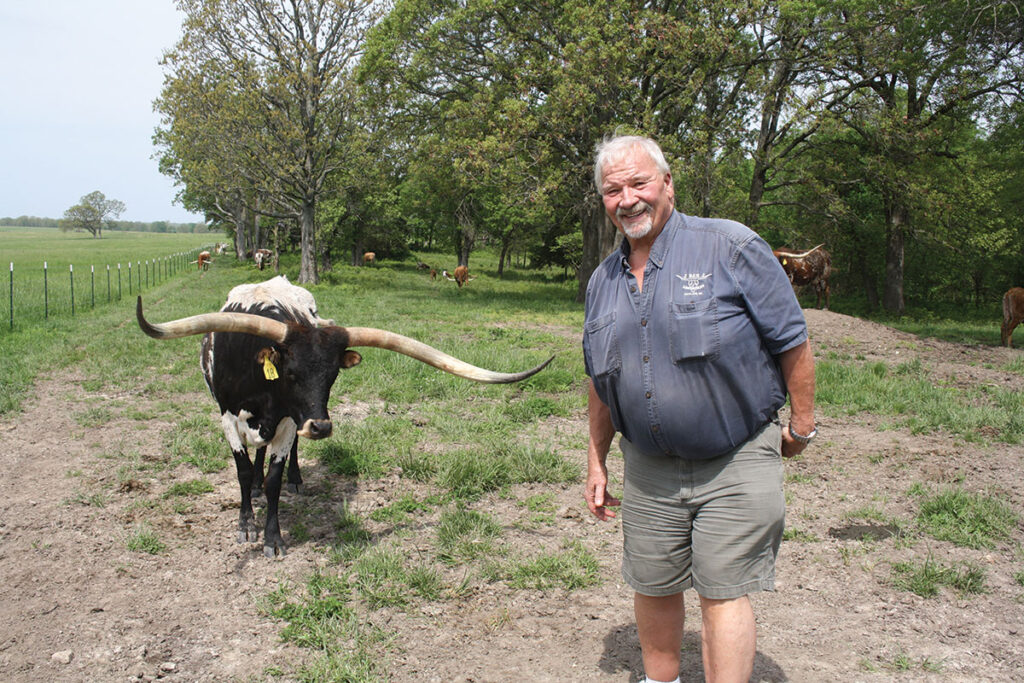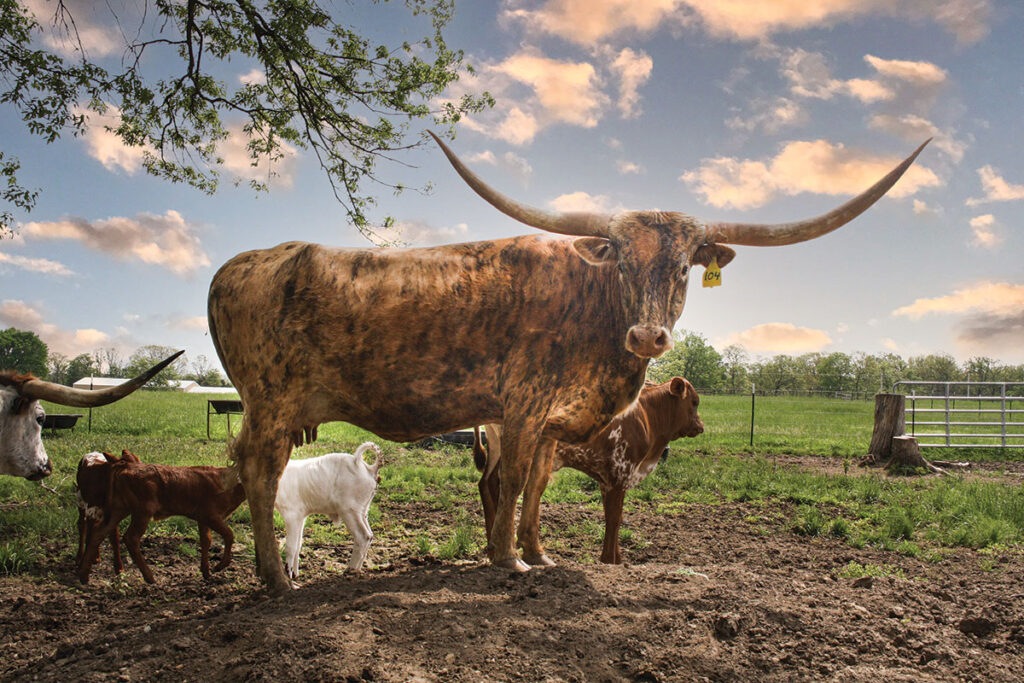
J Bar J Longhorns focus on improving the genetics of its growing registered herd
RICHLAND, MO. – After retiring, Rusty Clark was looking for something to do. He had spent a career in the marine industry, but it was time to try something new, something different.
“I have always been intrigued by Longhorns,” Rusty said. “One day, I was visiting a friend who had Longhorns, and I thought I needed to get one, a trophy steer; one of those steers people drive by and look at. I got one, and he just stood out there in the pen. My wife said he needed company, so I bought four heifers and a bull.”
That was in 2009, and Rusty and his wife JoAnne now have about 50 head of registered Longhorns on their Camden County, Mo., farm, outside of Richland.
“I’ve always done things I know nothing about,” Rusty said. “Learning is good for me. I don’t know everything, but I have learned a lot. They are incredible animals. Each one has its own personality. I enjoy going out in the field and talking to them, and you never have an argument.”
A trait that appeals to Rusty is the diversity within the Longhorn breed.
“They aren’t all the same color,” he said. “When you look out in the pasture, you see different colors and not just a bunch of black cows.”
J Bar J Longhorns is a seedstock producer and works to grow and develop trophy horn animals.
“The horns are really where the value is. Pedigrees are a big deal,” Rusty said, adding that half ownership of two of the top Longhorn sires in the country, which are sire and son, recently sold for a combined $500,000. “You can buy pedigrees or you can raise them; I want to raise them.”
In addition to retaining heifers and some bulls,
Rusty purchases outside cattle to help create the genetic diversity he wants to achieve in his herd, but he has some of his foundation females, which he said will never leave the farm. Rusty took a chance with two embryos sired by one of those top-selling bulls and implanted them into Angus recips.
“I got a heifer and a bull coming,” Rusty said, adding that the two sires are homozygous black and white, which is the current popular color pattern.
Rusty said conception rates with embryos and AI have been meager or have failed in the past, so the use of those practices is limited.
“I have never had an embryo take in a Longhorn,” he said, adding that AI is more time consuming than natural breeding and still utilizes a clean-up bull. The J Bar J bull battery gives Rusty the diversity he is looking for within his herd, so he likes to let nature take its course.
While Angus are known for easy calving, Rusty said the Longhorn beats the breed, hands down.
“We have to watch it,” Rusty said of his recip females. “An Angus will only dilate to 90 cm, whereas a Longhorn will dilate to 120, so you seldom have to pull a calf; I haven’t pulled one in 15 years. I have a neighbor who said if I ever had trouble to call him because he as everything we need. I have not the first inkling how to do it.”
The maternal traits of a Longhorn are very strong.
“They will hide their babies,” Rusty said. “I have thought a calf died because I couldn’t find it for four or five days, and I look hard for those calves. The next thing you know, there it.”
J Bar J’s calving season is mainly in the spring, but Rusty has made some adjustments.
“In Texas and down south, they like to birth in the fall, so you have to be careful when bringing in a cow because you don’t want it to birth in the winter here,” he said. “I like my calves in March or April, but I will have some August and September calves this year. I breed at 18 or 19 months, but I had a nice set of heifers I didn’t want to wait until June to breed. That would have been six months lost.”
When purchasing cattle from outside the Ozarks, Rusty brings them in the spring, which gives the animals time to acclimate to the Ozarks weather before the winter chill starts.
Longhorns also adapt well to forages in the Ozarks.
“Fescue is about all I have,” Rusty said, adding there is also some Timothy and Ladino and red clover in his pastures. “I brush hog once the seeds come out. The seeds bother their eyes, and that’s where the toxicity comes from.”
The herd, however, is not fond of clover but will eat it in the hay, which he bales from his 192-acre farm. His rotational grazing also allows Rusty to manage forges well and easily move cattle.

Genetics are an essential part of Longhorn breeding programs, but Rusty said the Longhorns are a little behind other breeds.
“There aren’t a lot of people who DNA, but we are seeing more do that,” Rusty said. “I have almost all of mine DNAed to verify their heritage. Others will get that ribeye size, and other carcass data, but it’s not very prevalent in this industry.”
Particular genetics and pedigree are highly-sought in the Longhorn breed, but there is no guarantee what color or what horn size or shape will result from a mating.
“Black and white is harder to get because cattle have to be homozygous black,” Rusty said. “I’ve had calves come out brown, but when it matured, it turned black. There are high horns, there are low horns, and there are twisties. In the late 1980s, early 1990s, 60 inches from tip to tip was big. Today, it’s over 100 inches.”
Rusty added a young Longhorn’s horns grow 2 to 3 inches a month until they are about 5 years old, then slow down, but the horns never stop growing.
“Once they get up to about 10 years old, they are still growing, but only an inch or two a year,” Rusty said. He added that black horns don’t grow as fast, but they will grow longer.
The Longhorn breed is known for being very hearty, and cattle at the J Bar J are vaccinated twice a year by Rusty’s veterinarian, using specialized squeeze chutes that do not have a head gate. Rusty also measures each animal’s horns, which begin growing when a calf is about a month old, at that time. Branding with an electronic brand is also done when working cattle.
The sprawling horns of the Longhorn can be intimidating to many people, but the modern Longhorn is not known for aggressive behavior. Docility is important to Rusty, and any animal showing signs of aggression is removed from the herd.
“You can get a rambunctious one,” Rusty said. “If I get one like that, they don’t stay. My cattle know me, but they can get a little nervous around a new person.”
Rusty offers cattle some grain, which is a 20 percent custom mix, but only to keep the herd docile and easy to move.
“They mostly get mineral, salt and grass, and they are happy,” Rusty explained, adding that his mineral program included additives to battle heat-related issues and flies. “Feed is how I control them. I went to a sale, and a guy said it took him two weeks to get his cows up. I can get every cow up in 10 minutes with a bucket of feed.”
Longhorns do not sell well at typical livestock auctions, Rusty said. Those not kept for breeding or horn production or other culls are processed into ground beef.
“I don’t want a job,” he said. “I don’t want to have steaks and all these different things to worry about; I just do hamburger. It’s grass-fed, and when you cook it, you don’t have to drain off a bunch of fat.”
Growing up, Rusty watched westerns on TV and followed the charterers as they drove Longhorns along dusty trails, but he never desired to raise the iconic breed, not until he got that first steer.
“I always thought they were cool — and I still do,” he said. “I just love this breed.”







